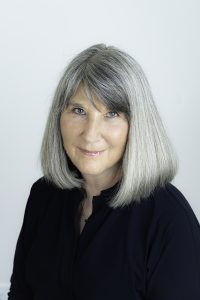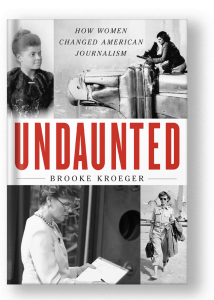Talking About Women’s History. A Bunch of Questions and an Answer with Brooke Kroeger
I am pleased to open this year’s Women’s History Month series with what turned out to be more- than-three questions and an answer with journalist and author Brooke Kroeger, whose most recent book, Undaunted: How Women Changed American Journalism (2003) explores how women have fared in American journalism’s most competitive and highly valued bastions, the ones men have dominated in the 180 years since mass media began. A topic that I have some interest in.
Brooke is also the author of Nellie Bly: Daredevil, Reporter, Feminist (1994); Fannie: The Talent for Success of Writer Fannie Hurst (1998); Passing: When People Can’t Be Who They Are (2003); Undercover Reporting: The Truth About Deception (2012), and The Suffragents: How Women Used Men to Get the Vote (2018).
Early in her career, she was UN Correspondent for Newsday and deputy metropolitan editor for New York Newsday. Over eleven years with United Press International in its Scripps Howard days, she reported from Chicago, Brussels, London and Tel Aviv, where she was bureau chief (1980-83) before returning to London to become the agency’s division editor for Europe, the Middle East, and Africa (1983-84). At NYU, she served on the journalism faculty from 1998 to 2021 and from 2005 to 2011 was department chair and founding director of NYU’s Arthur L. Carter Journalism Institute. She created the MA unit Global and Joint Program Studies and directed this joint program field of study from 2007 to 2020.
In short, Brooke is a woman who knows a lot about women in journalism.
Take it away, Brooke!
How did your own long career as a journalist shape the writing of Undaunted?
My background was essential to the work. It influenced the anecdotes I chose, the details I emphasized, the reflections those examples elicited, the questions I asked of the living and of the historical record, and the responses all of these elements evoked, ones that grew out of my own long experience and relationships over more than 50 years with other women journalists—both established and emerging—feelings, really, that remain common to us all.
You share the stories of a large number of women in Undaunted. How did you choose which women to include?
This was such a painful process and I know from a few comments in public forums that it is hard for some readers to accept who got left out in the winnowing. We wanted the text to be under 400 pages. Hence, the 120 pages of endnotes as I couldn’t entirely let go. And yet, it’s meant to be representative history—emphasis on representative.
I focused on women with outsized careers for their time in major mainstream publications and broadcast outlets or those who attracted major mainstream notice, not later in excavation, but in real time. I looked only for women doing what we might call men’s work, women who had jobs or held positions that men in the field would envy. Women who competed directly with men. This mattered especially in the years when this was far less common than it is today. That meant no women’s magazine denizens (e.g. Gloria Steinem only as a freelancer before Ms.), no activists, no writers who wrote or broadcast primarily in languages other than English.
In the introduction, I explain my method. For consistency, I used dozens of proprietary databases from 1840 to the present and applied the same two search terms to every decade: “women” “journalism.” This gave me “a good sense of the conditions that governed the presence and place of women as journalists, the ideas about them that prevailed in each period, and how those ideas changed, or did not change over time. It became possible to identify the individuals whose achievements received the most attention. I considered how and why some women attracted publicity and if and how their stories fit into the wider context of women’s advancement.” I told the story in strict chronology, decade by decade. The dominant theme of progress-setback-progress-setback guides the telling. On top of all that, I gave precedence to the episodes that dealt with or dovetailed with the most significant news events and trends of each period.
I used 12 questions as guides: Which stories best illustrated what women were up against in their professional lives? How or why did the most successful women first get in the door? Who were the true trailblazers and pioneers? (Sidenote from Brooke: those words erroneously get thrown around far too often.) Assuming talent and hard work, how much did background, privilege, strategy, charisma, style, looks, advocacy, connections, or luck figure in their ascent? How well did women manage their successes and failures, their celebrity and censure? Were they “womanly” or “manly” in their reporting and writing or in their editorial vision? What impact did they have on the nation’s news diet and on the profession? Whom among women has the wider journalism community chosen to honor? Which qualities and characteristics fairly or unfairly attributed to women brought condemnation? Which brought respect? How did newsroom politics figure? Have women made a difference? I liked the opportunity to highlight great friendships and I gave due respect to the men who gave deserving women opportunity when so many others would not.
Was there a woman you were sad to leave out?
So, so many. In many cases this was because the most compelling contours of those personal stories were too similar to those of predecessors from earlier decades whom I had already detailed. See above.
You introduce readers to a lot of fascinating women in Undaunted. Do you have a favorite, or two?
Again, so many. This would include all the well-remembered you would suspect with a special place for Charlayne Hunter-Gault. And from the entirely forgotten, don’t miss Edith Evans Asbury, who defied all odds to become a brilliant New York Times metro reporter (but not until her 40s!), serving from 1952-1981, and Ann Stringer, the United Press World War II correspondent, who, like a few others, defied no-women-allowed regulations to report up the Rhine, but then also scooped every other reporter on the Russian-US linkup at Torgau, and produced scoop after scoop from Nuremberg working under Walter Cronkite, then also with UP.
What was the most surprising thing you’ve found doing historical research for your work?
In a field that puts a high premium on youth, how many enormously successful early 20th century women journalists hit stride in middle-aged, e.g. Pauline Frederick, Marvel Cooke, Ethel Payne, Edith Evans Asbury.
A question from Brooke: If you’ve read the book, what was your most significant take-away?
The clear sense that more women worked as serious reporters than the shorthand version of the story tells us, something I’m finding to be true in more and more historical contexts.
* * *
Want to know more about Brooke Kroeger and her work?
Check out her website: https://brookekroeger.com/
Follow her on Twitter: @brookekroeger
Come back tomorrow for three questions and an answer from Lori Davis, writer and producer of the Her Half of History podcast.







Wonderful to know more about Brooke Kroeger and her most recent work!!
Thanks Pamela. I look forward to reading more!